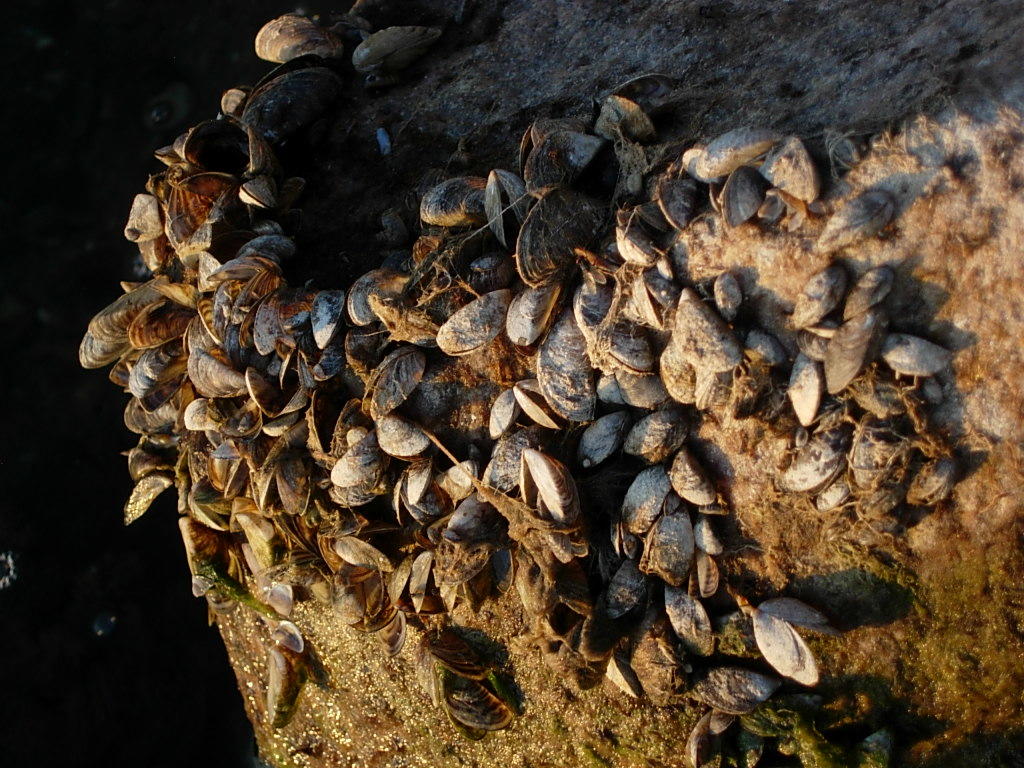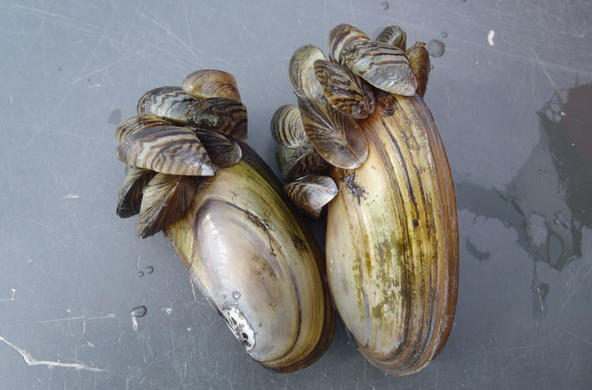
The zebra mussel (Dreissena polymorpha) is a small bivalve native to fresh and brackish waters in the Caspian Sea region of southeastern Europe. It was accidentally brought to the Great Lakes of North America in the 1980s in the ballast water of an ocean-going ship. Since then, the zebra mussel and its cousin the quagga mussel (Dreissena rostriformis) have spread widely across North America. Both species are very abundant filter-feeders, and have disrupted many aquatic ecosystems.
Zebra mussels appeared in the Hudson River in 1991, and have caused large changes to many parts of the ecosystem, from water chemistry to fish populations.
Life history and biology of zebra mussels
Adult zebra mussels are 1 to 3 centimeters long, and often have a striped black-and-white shell, which gives them their name. During warm months, when the water temperature is above about 10° C, female and male zebra mussels release eggs and sperm into the water.
Zebra mussels are very prolific, and can produce as many as 1 million eggs per year. Fertilization takes place in the water, and the tiny larva (called a veliger; it’s only about 0.2 millimeter long) that is produced spends a few weeks floating in the water, feeding on tiny plankton and bits of detritus. After it is fully developed, the larva settles onto a solid underwater surface such as a rock, concrete, wood, a plant, or a native mussel shell, and becomes a juvenile.
Zebra mussels cling to surfaces by using thread-like strands called byssal fibers tipped with a strong, sticky substance. Once attached, they generally stay in one place, but can detach and crawl to a new location if environmental conditions change. Mortality is very high during the larval period, and few of the veligers survive long enough to settle. Juveniles grow rapidly, and usually are mature and ready to reproduce in their second year. They typically live for 1-5 years.

Zebra mussels are filter-feeders, pumping water through their gills and removing small edible particles from the water. Their food includes phytoplankton, small zooplankton, large bacteria, and detritus. An adult zebra mussel will filter 1 to 10 liters (0.5 to 2 gallons) of water a day. In turn, zebra mussels are eaten by several kinds of fish (sturgeons, freshwater drum, catfishes, and others), diving ducks, crayfish, and (in the Hudson) blue crabs.

How did zebra mussels arrive in North America and how did they spread?
Zebra mussels are easily transported as veligers in untreated water (ballast water, bait buckets, live wells), or as juveniles or adults attached to boat hulls or aquatic plants.
Both zebra mussels and quagga mussels probably arrived in untreated ballast water that was dumped into the Great Lakes near Detroit in the 1980s. Both species were first seen in Lake Erie later in the 1980s, and have spread rapidly all across North America, probably traveling with river currents and on recreational and commercial boats.
They are still spreading, and are likely to be excluded only from temporary waters, small streams, very warm waters, and waters that are low in calcium.

What are the ecological and economic impacts of zebra mussels?
Zebra mussels have had large impacts on North American ecosystems. Three characteristics of zebra mussels give them such large impacts.
First, they often are very abundant. Populations often reach thousands of animals per square meter (hundreds per square foot) of lake or river bottom – the quagga mussel population of Lake Michigan was estimated to contain more than 100 trillion animals.
Second, zebra mussels filter a lot of water, so a dense zebra mussel population can remove most of the suspended particles from a river or lake. This can starve other parts of the ecosystem that used to depend on plankton, as well as making the water clearer, allowing better growth of submerged aquatic plants.
Third, the mussels and their shells can change the physical and chemical nature of habitats at the bottom of the river or lake. For instance, zebra mussel beds provide habitat for some invertebrates, as well as providing the right conditions for the bacteria that produce botulism to thrive. Sometimes botulism kills many waterbirds in lakes that have been invaded by zebra mussels. When zebra mussels arrive in an ecosystem, they can change it in many ways, both good and bad.
Zebra mussels can also have direct economic impacts. The best-studied of these impacts is the blocking of pipes and other structures in power plants, drinking water intakes, etc. that draw water from infested lakes and rivers. Water intake pipes provide an excellent habitat for zebra mussels because they provide both protection and a constant flow of water, and, hence a steady food supply.

In the Hudson River and elsewhere, companies spend a lot of money (hundreds of millions of dollars across North American since the mussels arrived) to keep infrastructure clear of zebra mussels.
Invasion and transformation of the Hudson River ecosystem
Zebra mussels first appeared in the Hudson in 1991. The population grew rapidly – by the end of 1992, they had spread throughout the river, and their biomass was greater than the combined biomass of all other consumers (fish, zooplankton, zoobenthos, bacteria) in the river. Densities in the Hudson can reach over 100,000 individuals per square meter (10,000 per square foot).
Quagga mussels appeared in the Hudson in 2008, but their population has remained small. Since there are so many zebra mussels in the river, they are able to filter all of the water in the freshwater portion of the Hudson River every 1-4 days! (Before the invasion, the native mussels filtered the water only every 2 months.)
Cary scientists observed profound changes in the Hudson River ecosystem after zebra mussels arrived. The food web changes that the mussel has caused compare in magnitude to disturbances in other aquatic ecosystems caused by toxins, nutrient pollution, or acid rain.

Phytoplankton populations fell by about 80%, and populations of zooplankton small enough for zebra mussels to eat (like the rotifer pictured above) fell by as much as 90%. As a result, parts of the ecosystem that depend on plankton declined (like the American shad shown below).
A modest increase in water clarity allowed submerged aquatic plants, and the animals that depend on them (like the redbreast sunfish shown below), to do a little better. Because these plant beds cover only a small part of the Hudson, the overall effect of the zebra mussel invasion was a loss of other consumer populations in the river.


But these effects have changed over the course of the zebra mussel invasion. A few years after the initial invasion, predation rates on zebra mussels (chiefly from blue crabs) rose, resulting in a zebra mussel population that contained almost no large, old animals (although the number of mussels in the river did not decline).
Because large zebra mussels eat different foods than small ones, this shift in mussel sizes caused their impacts on the ecosystem to change. For example, populations of small zooplankton have rebounded, probably because small zebra mussels can’t eat them.
Although zebra mussels have been in the Hudson for more than 30 years, their impacts on the ecosystem probably have not yet equilibrated.
How can we control zebra mussels and prevent the spread of aquatic invaders?
Zebra mussels can be controlled in industrial facilities by chemicals (often polyquaternary ammonium compounds, or compounds containing chlorine or copper), or by coating or scraping the pipes. A bacterial toxin called Zequanox®, which is deadly to zebra mussels but relatively harmless to most other organisms, may also be useful. However, in most cases it is not feasible to control zebra mussels once they are established in a lake or river.
Probably the best way to manage zebra mussels and other harmful invaders is to keep them from arriving in an ecosystem in the first place. For zebra mussels, this means cleaning boats and other equipment before traveling from an infested body of water to an uninfested one, and not carrying live mussels or untreated water from one lake or river to another.
For invaders that have not yet arrived in North America, we can better control ballast water and the movement of species in the horticulture and pet trades, bait buckets, canals, etc. Such preventative measures can reduce invasion rates and save money.
Glossary
Alien species: a species that was moved outside of its native range by human activities and established populations in the wild (also called exotic, non-native, non-indigenous, introduced). This does not apply to domesticated species.
Byssal fibers: thread-like strands adult zebra mussels produce to attach to firm objects.
Detritus: bits of vegetation, animal remains or waste, and other organic material that form the base of food chains in many ecosystems.
Drainage basin: a region including land and water which drains to a particular point; also called a watershed.
Ecosystem: a system of interrelated organisms together with their physical and chemical environment.
Food chain: the sequential transfer of food energy from one species to another. Higher species in the chain consume lower species in the chain.
Invasive species: an alien species that causes ecological or economic harm.
Mollusk: a group of invertebrate animals that includes snails, slugs, clams, mussels, oysters, squids, and octopuses.
Plankton: small, usually microscopic, plants and animals that float in the water.
Predator: an animal species that captures other animals, its prey.
Veliger: microscopic larval stage of the zebra mussel.
Fact sheet prepared by freshwater ecologist David Strayer.




